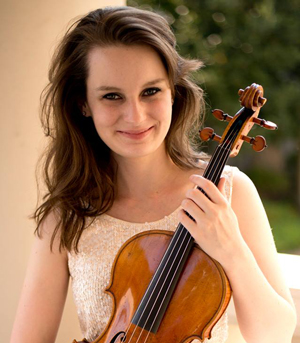by Carlyn Kessler

Originally from Wilmette, Illinois, Leah is a senior at CIM studying with Robert Vernon and has recently participated in festivals including Ravinia, Music@Menlo, the Perlman Music Program, and the Sarasota Music Festival. She has collaborated with artists including Itzhak Perlman, Miriam Fried, and members of the Cleveland, Orion and Tokyo quartets. Most recently, Leah appeared with Joshua Bell on the television program “A YoungArts Masterclass,” which aired on HBO last October.
I had an illuminating recent conversation with Leah about her evolving experience with the Bartók concerto and her preparation for the upcoming performance.
Carlyn Kessler: When did you start working on the Bartók?
Leah Ferguson: I began working on it in high school when I was 15. There are three standard viola concertos that are most familiar to us — Walton, Hindemith, and Bartók. Of these standards, the Bartók is most familiar to me.
CK: Is the Bartók your favorite?
LF: Yes, it is my personal favorite!
CK: Have you performed it with orchestra before?
LF: No, this will be my first time, and I’m very excited! It’s really special to be performing it in Severance Hall. I’m lucky to be able to hear Mr. Vernon and all of the Cleveland Orchestra members play there every week, and I feel very fortunate to be performing in the same space.
CK: You’ve had a lengthy experience with this piece. Has your interpretation evolved since you began working on it?
LF: Since I first started working on this concerto, I’ve had more experience playing Bartók’s music in orchestral and chamber music settings. The more Bartók I’ve played, the more my concept of his style has developed. The Viola Concerto is one of his last works, and it clearly shows elements of his later style. I have come back to this piece many times since I was 15, and I think that each time I have a better understanding of Bartok’s musical language.
CK: What are your favorite aspects of this piece?
LF: I love the gorgeous and unusual harmonies he uses. The collaboration between the viola and the orchestra creates beautiful sonorities, especially in the second movement. Paired together, the ensemble and solo part set up an extremely gripping atmosphere. Also, the viola part has many great “Bartókian” melodies that are folk-inspired and fun to play.
CK: What are its the major challenges?
LF: The piece utilizes the whole range of the instrument, and there are quite a few passages in a very high register. Bartók dives right into this from the start of the piece. It is a very athletic work with many hurdles in the solo part.
CK: Do you think it will be challenging to put it together with orchestra?
LF: I’m expecting that it will be pretty straightforward. It is clear when the viola comes in, and the texture is well balanced while the soloist is playing.
CK: Does Bartók include any special techniques in this piece?
LF: He incorporates a lot of exotic scales, modes and chromaticism, as well as folk songs.
CK: How does Bartók’s concerto relate to the other standard viola concertos?
LF: It was written after the Walton and Hindemith concertos. He had heard both of those concertos, which contributed to his increased appreciation of how to balance the viola with orchestra. But stylistically, the piece is uniquely Bartók — or as much as it can be considering the fact that it’s unfinished.
CK: Tell me more about that.
LF: Unfortunately, Bartok died before he could complete the piece, and the fact that it was left unfinished has sparked much debate over time. Bartók left behind multiple fragments and sketches, and a few people have taken on the challenge of completing the piece. There are several versions, one of which was created by his son, Peter. I am playing the first version, by his student Tibor Serly, which is the most standard.
CK: What excites you most about this Severance Hall performance?
LF: The hall is so beautiful, and the acoustics are truly ideal. Mr. Vernon has played the Bartók Concerto in Severance many times. So, it is extremely special to me that I am studying this work with him in my final year at CIM, preparing it to perform in the hall that has been central to his career and his work with The Cleveland Orchestra. It is wonderful that CIM offers us the chance to work with so many world-class musicians in such close proximity to The Cleveland Orchestra. The fact that the CIM orchestra gets to perform in TCO’s home of Severance Hall is amazing, and I feel extremely privileged to be featured there.
Published on ClevelandClassical.com November 18, 2014.
Click here for a printable copy of this article


